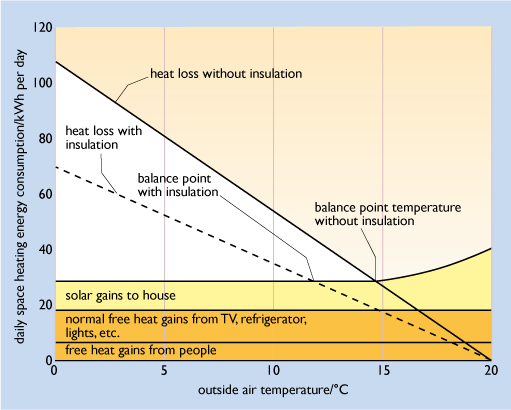2.4.3 Balance point temperature
In practice, the degree day concept should be treated with caution when dealing with well-insulated buildings. It may seem strange that degree days are to a base of 15.5°C and not the actual internal temperature of the building. The degree day base temperature is assumed to be that below which the heating system is likely to be needed. This is in fact likely to be a function of the level of insulation. This problem is explored in Figure 23 which shows the estimated daily heating requirements for a 1970s house, with and without extra insulation.
On any given day the gross space heating will depend on the external temperature; the colder it is, the more heating energy will be required. However, there will always be a certain amount of internal free heat and solar gains. The space heating system itself will only need to supply heat if these are not sufficient to keep the house warm enough. We can describe this as the net space heating demand.
This will only be required if the external temperature falls below a certain ‘balance point temperature’. Below this the free heat gains cease to be sufficient to keep the house at the chosen internal temperature, assumed to be 20°C in Figure 23. In this particular house in its uninsulated state the balance point appears to be just under 15°C; it is certainly considerably lower than 20°C. We could say that the heating demand of this house requires degree days to the base 14.5°C rather than 15.5°C.
In fact the degree day concept is very old and predates any notion of insulation in the UK building stock. An assumption of a ‘balance point temperature’ of 15.5°C was quite appropriate for estimating the space heating consumption of the buildings of the 1950s and 1960s. However, it is still useful in basic energy monitoring and targeting in buildings today.

